|
|
A KV for every season
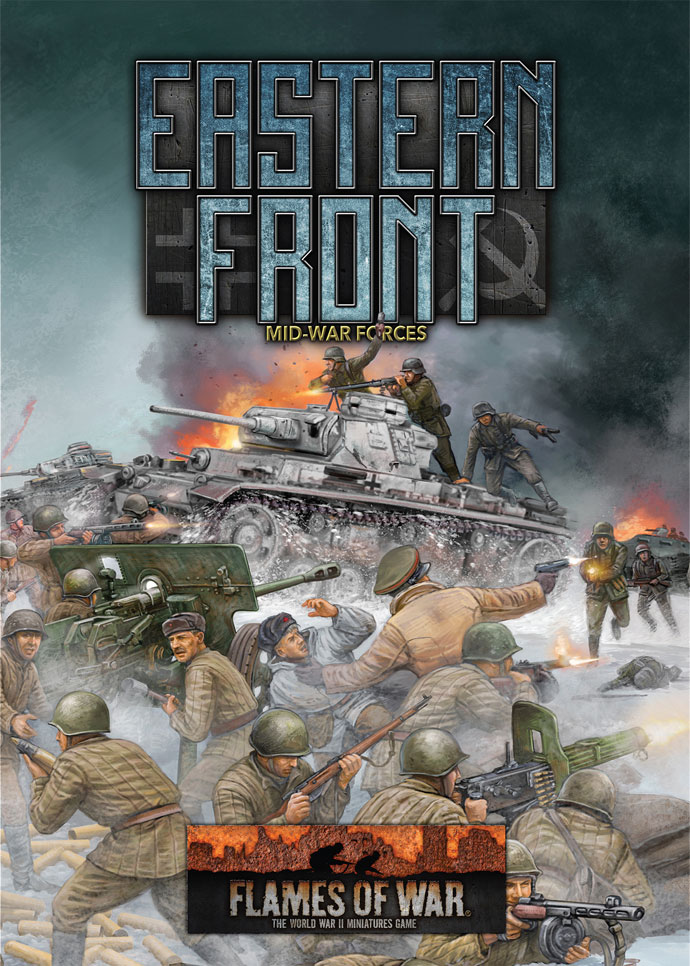 |
A KV for every season
With Livio Tonazzo
The KV heavy tank, named for Soviet defence commissar Kliment Voroshilov, was among one of the best Soviet tanks produced and one of the most long-lived! Its first versions were built in the late 1930s, it was used in the 1939 Winter War against Finland and remained in service until February 1944 when it was replaced by the more modern IS-2. Among other things, the hull continued to be used as a base for self-propelled artillery.
While fielding forces from Fortress Europe, Enemy at the Gates and Red Banner we had already got to know them, play them, and appreciate them. Especially in their basic KV-1 version or in the KV-8 flame-thrower (but not the KV-1s to be clear), the KVs have proved to be exceptionally resistant tanks, capable of withstanding hits from high anti-tank value guns without suffering serious damage, while ignoring all hits from medium to light anti-tank weapons. Not only that, thanks to their Side Armour of 8 and Top Armour of 2 they are perfect tanks for assault. This is especially true in Mid-War where you can count on few infantry anti-tank weapons.
|
|
The new Eastern Front book introduces two new versions of KV and a lineup dedicated to them, the KV-5 and the KV-3.
Let us go into detail to see the characteristics of these new steel giants.
|
|
Common Features
I will start this section with the Unit ratings that largely fall outside the tank model’s characteristics. However, since these are very similar tanks and of the same series, with similar Training, Motivation and Hit On ratings, I will look at both of them together.
The KV-3 and KV-8 are extremely easy to hit. There is no worse value than a Reckless 2+: this means that 84% of shots will hit the target, that is five out of six hits. This very often means certain death for lighter tanks. However, it is different for KVs because their excellent armoured protection, which makes a massive difference. Nevertheless, we must still be very careful not to move too casually or not take anything for granted. More on this later in the article.
|
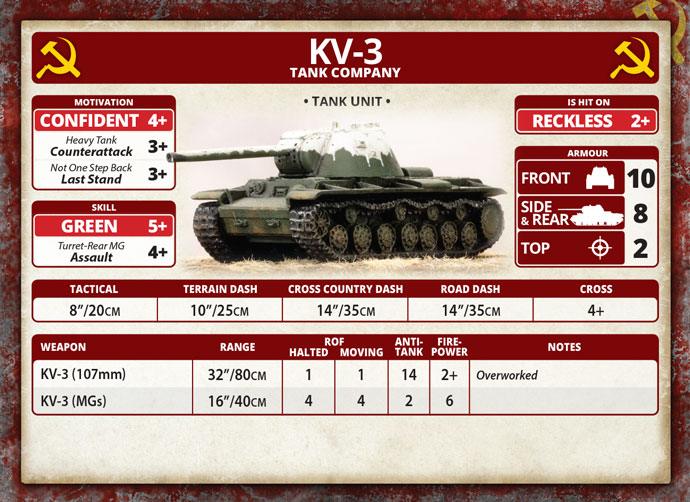 |
Training is very poor and reflects the complicated situation of the Soviet tanks in 1942-1943, to say the least. With a value of Green 5+ there is little chance of using orders effectively, so better not to rely on Movement Orders too much, using them if there is nothing to lose. On the other hand, the effectiveness in the Assault is better, thanks to the machining-guns in the turret. The KVs strikes in an assault with a value of 4. Definitely better! They are not lethal killing machines, but they can still do their job well enough. |
| As for Motivation, the situation is slightly better. The crews are not particularly motivated but are still resolute in doing their duty. Motivation has a neither good nor bad with a rating of Confident 4+. This value will mainly be used for the Remount, as the Soviet No One Step Back rule confers a Last Stand value of 3+, which makes the Unit unlikely to flee. The tonnage of the KV instead instills a lot of courage in the crews, especially in the Assaults. The Heavy Tank rule gives a Counterattack value of 3+, KVs are definitely war machines at ease in Assaults, so you should take advantage of all these rules. |
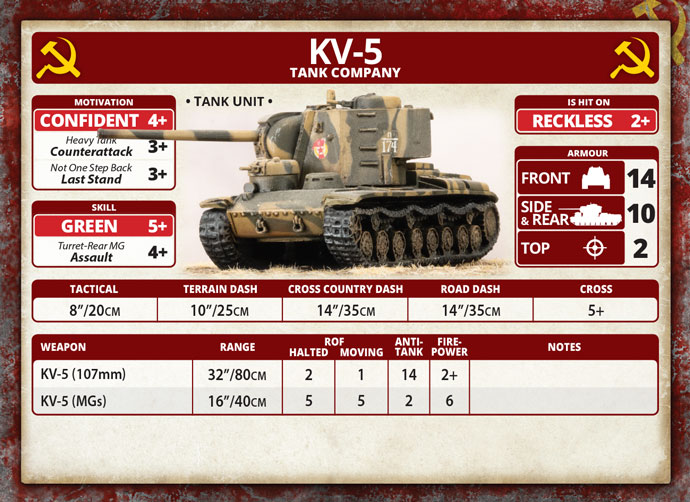 |
| KV series tanks have never shone in the area of mobility. Except for the KV-1S version which had a less thick armour, all other versions suffered quite evidently from the weight/power ratio. The maximum speed of 35km/h (on the road) is rendered in terms of play with a Tactical Speed of 8”/20cm, which is 20% lower than the standard Tactical Speed. This is certainly not an uncommon handicap but it certainly has an impact in terms of play. It means a limitation when you want to move and then shoot, because getting to the desired position may be more difficult or even impossible at times. Even the speed with which you can attack is limited, although you can try to make up for it with a Follow Me order. It will not be surprising to know that the KV is not particularly well performing even in terms of Dash Speed. With a speed of 14”/35cm in Cross-Country and Road Dash, you can still gain ground quite quickly as the difference is not that great compared to the values of other medium tanks. On the other hand, it is particularly expensive in terms of time to cross terrain with only 10"/25cm Terrain Dash. This is the Tactical Speed value of most other tanks. However, it is slightly higher than the KVs Tactical Speed. |
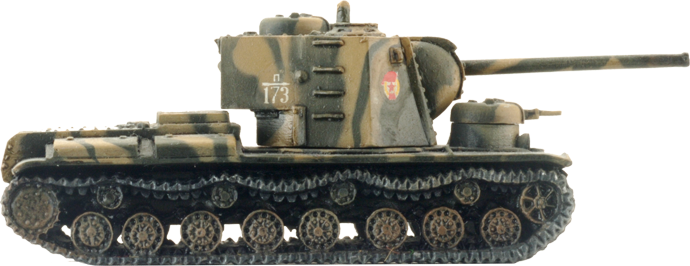 |
Terrain
We have seen how the movement characteristics have not changed between the various KV models. However, it is not entirely correct to say that the mobility of the tanks in question, KV-1, KV-5 and KV-3 has remained unchanged. A careful observer will notice that one value changes significantly from one version to another. This is the Cross value which expresses the tank's ability to cross terrain without getting stuck. It is particularly important for slow tanks precisely because they often do not have enough movement to get around obstacles and are therefore forced to cross them.
|
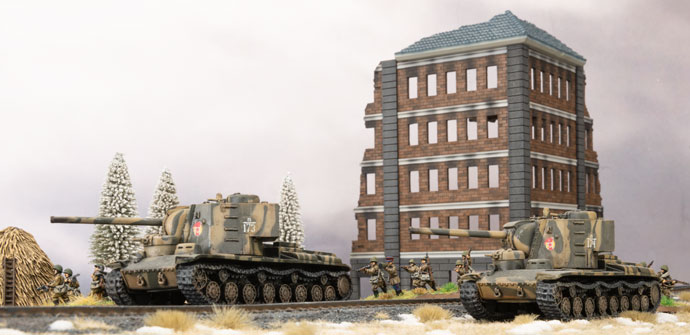 |
|
For tanks that give their best in assault it is doubly more important since infantry it often found entrenched in woods, on hills, or behind walls.
While the KV-1 has a Cross value of 3+, not exceptional but still very good, the KV-3 has a Cross value of 4+ while the KV-5 even manages to get worse with a value of 5 +. From my point of view, these mediocre or bad values force the KVs to avoid crossing the land as much as possible unless the operation is painless, i.e. "no costs" in case of failure.
|
|
Armour
The armour values of the new KV-5 and KV-3 are one of the two differentiating factors compared to the other versions already plowing the battlefields. The KV-1 had a Front Armor value of 9, which makes it effectively immune to light and even medium anti-tank hits, competitive with medium-high armor value (12-14), but left it unprotected compared to high anti-tank values (17). Fortunately, in Mid-War only Germans with Pak43 (8.8cm anti-tank gun, Ferdinand, and Hornisse) have such high anti-tank values and pay dearly in points for it. The Side Armour is 8, and this makes the KV particularly suitable for conducting Assaults as well as offering excellent protection from the flanks of medium tanks. Considering that there are very few infantry anti-tank weapons in Mid-War and only few nations have access to them, these are tanks capable of resolving matches if used at the right time for the decisive assault. Top Armour, on the other hand, helps in this. In addition good Top Armour offers good protection from Artillery and Aircraft.
|
|
The new KVs are even better performing in terms of armour.
The KV-3 differs only in an extra point in the Front Armour, a point that however can make the difference when facing anti-tanks of 12 (rendered practically harmless) and the anti-tanks of 14 that come out decidedly reduced, especially at long range. However, it must be said that weapons such as 8.8cm guns and 17pdr guns are still dangerous. Even at short range only 33% of the shots will be completely blocked by the armour, 16% could result in a bailed out, while 50% will penetrate the armour risking the destruction of the tank. It is therefore necessary to try to keep to the long range (beyond 16”/40cm) until it is strictly necessary to reduce the statistics described above.
|
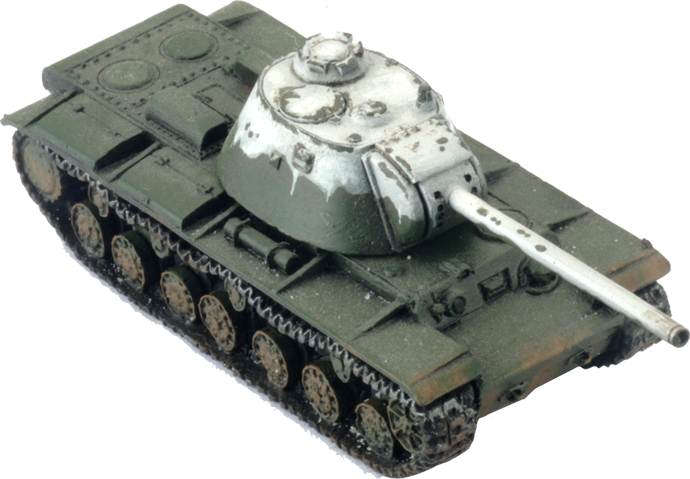 |
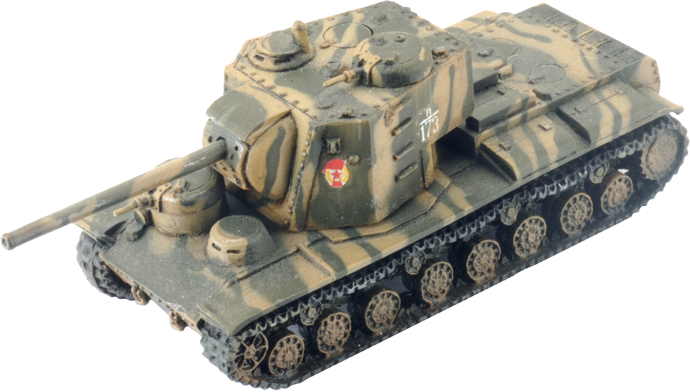 |
The KV-5 on the other hand is something different. Thanks to its Front Armor of 14 it is able to blissfully ignore the shots of the 8.8cm gun, fearing only those of the long 8.8cm Pak43 with an anti-tank of 17. This makes the KV-5 the perfect opponent for Tigers and Panthers as their anti-tank 14 cannon is ineffective, while the KV-5 cannon can easily penetrate the opponent's armour. The most dangerous opponent for the KV-5 is the Ferdinand which is absolutely immune to the cannon of the KV-5, while the Ferdinand can penetrate the armour of the KV-5 thanks to its anti-tank 17. The KV-5’s Armour 14 still offers a level of protection: 50% of the shots will bounce off the proud Soviet steel, 16% will be able to obtain a bailed out effect at most while 34% (one in 3) will penetrate the armor and have a chance to destroy the tank. |
| Beyond 16”/40cm, however, the chance is further reduced and only one result in 6 (16%) will have the chance to destroy the tank. The advice against a Ferdinand, if you cannot hide, is to stay at long range and devote yourself to other targets while ignoring the huge self-propelled vehicle. In addition, the KV-5 also has an exceptional Side Armor of 10, great for virtually ignoring any unit that can bypass it, barring gross errors. |
|
The Guns
The other second differentiating factor between the various KV models is the cannon. The KV-1 is a tank characterized by the incredible ability to absorb blows received and make its weight felt in the assaults. The offensive ability is less exciting. In addition to the two machine guns, one coaxial and one on the hull, the KV-1 can count on a 76mm gun, with a range of 24”/60cm, an anti-tank value of 9 and a Firepower of 3+. The ROF is 2 when halted and 1 while moving. Unfortunately, the Overworked rule imposes a +1 penalty for moving and shooting. The KV-5 and KV-3, on the other hand, have other offensive capabilities.
|
| The KV-3 is armed with a 107mm gun, which with an anti-tank value of 14 and a Firewpower of 2+ can easily destroy almost any tank it faces. The range is decent, 32"/80cm, although lower than similar German guns, all in all it is definitely an effective weapon. The gun of the KV-3 also maintains the Overworked rule, although the big limitation of this gun is the ROF of 1 both while moving and halted. This is definitely a problem when facing Careful opponents who are particularly hard to hit. The 2+ Firepower should at least help capitalize on hits. |
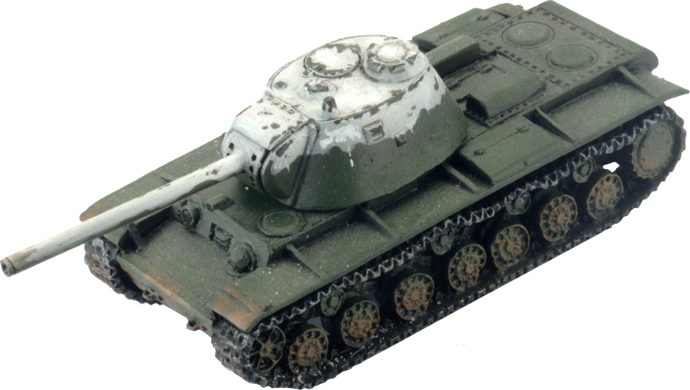 |
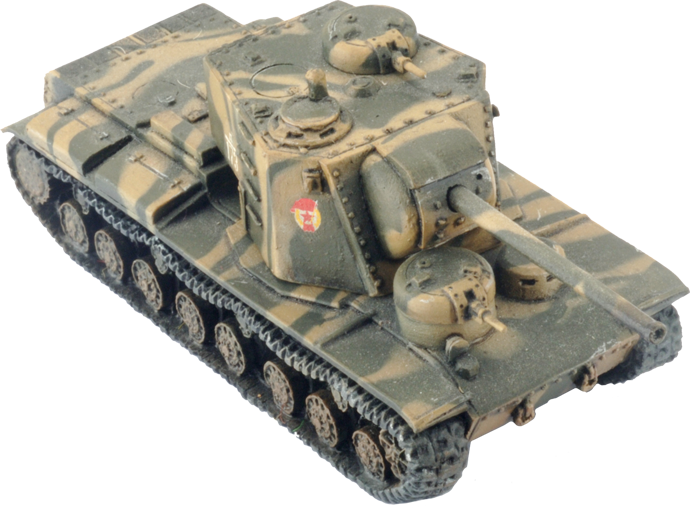 |
The KV-5, on the other hand, is equipped with a better performing 107mm gun. In fact, it does not have the Overworked special rule (due to having are larger turret and more crew) and instead has a Halted ROF of 2 and a Moving ROF of 1. Combined with an Anti-tank value of 14 and an exceptional Firepower of 2+ it gives the KV-5 excellent lethality. The only flaw is the lower range compared to the German 8.8cm gun, the 8"/20cm difference could be felt even if the Front Armour allows you to get closer compared to the enemy without too many worries. Overall, this is a very good anti-tank for the Soviets, maybe that is just what was needed. To top it off, the KV-5 has an extra machine gun. |
|
Points Costs
If you are already worrying about the point cost of these huge tanks, don not worry too much! Two KV-5s, thanks to the value of Is Hit On Reckless 2+, cost about 10% more than a single Tiger. A cost in points that is certainly important but still manageable in the economy of the list. Keeping two KV-5s in reserve allows you to play with almost only one reserve, which means having almost everything on the field on the first 5+ roll.
|
|
Among other things, it should be considered that it is an excellent anti-tank for the Soviets, an area the Soviets are usually somewhat lacking in.
The KV-3 on the other hand is cheaper, but not that much. Two KV-3s are about 10% less than a single Tiger. Again this is an expense, but possibly worthwhile. There is really no excuse not to play the new KVs!!!
|
|
|